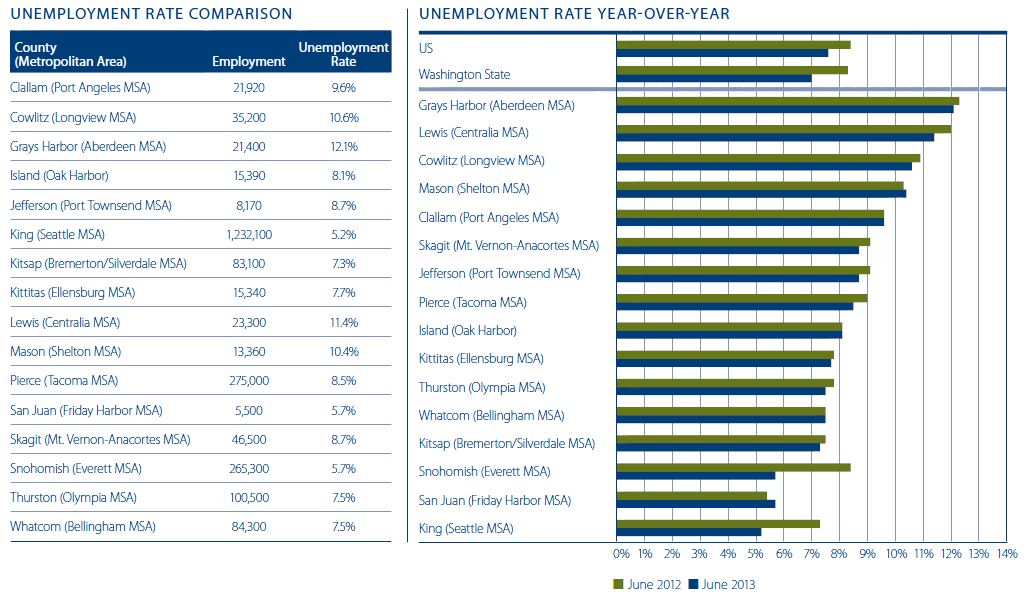Windermere Real Estate is proud to partner with Gardner Economics on this analysis of the Western Washington real estate market. This report is designed to offer insight into the realities of the housing market. Numbers alone do not always give an accurate picture of local economic conditions; therefore our goal is to provide an explanation of what the statistics mean and how they impact the Western Washington housing economy. We hope that this information may assist you with making an informed real estate decision. For further information about the real estate market in your area, please contact your Windermere agent.
Regional economics
It is becoming apparent that economic growth in Washington State, although certainly continuing to expand, is starting to exhibit growing pains.
As far as total employment is concerned, the numbers appear to be robust with the market area adding 50,670 new positions over the past 12 months. I should also note that the market added 46,250 in the past quarter, but this is not surprising as county level data is not adjusted for seasonality.
Total employment growth over the past year was seen in all but seven counties. I am not too concerned about the markets that shrank as they were, in general, very small declines in equally small counties.
Unsurprisingly, year-over-year, King County (+3.3%) grew at the fastest rate. This was followed by Skagit (+3.1%), due to a jump in hospitality employment that I attribute to the pending reopening of the Semiahmoo Resort. Whatcom (+2.4%), Pierce (+1.9%), and Thurston (+1.8%) Counties rounded out the other top performing counties.
As mentioned previously, job losses were generally modest, with San Juan (-5.8%), Cowlitz (-2.8%) Grays Harbor (-2.4%), and Clallam (-2.0%) Counties suffering the greatest percentage losses. In aggregate, the areas that saw a reduction in employment lost a total of 2,460 jobs. We would note, however, that no counties saw losses between the end of the first quarter and the end of the second quarter of this year.
In terms of absolute numbers, it was not surprising to see the primary central Puget Sound region leading the way in terms of total growth. The tri-county market added 47,500 jobs over the past 12 months, including 36,700 jobs in second quarter, suggesting growth rates of 2.75 percent and 2.11 percent respectively.
I did mention earlier that I saw some growing pains in our region, and this is clearly reflected in the unemployment rates. Five counties saw their unemployment rates rise between the end of the second quarter of 2012 and the end of the current quarter.
The reason for this is that, as the economy continues to grow, more people will start to look for work, and the unemployment rate is calculated based upon the number of people actively looking for work. With that in mind, do not be surprised to see improvement in the unemployment rate start to slow—specifically in the more urban counties. In June, 14,900 more people started to look for work, and over 23,000 are now seeking employment that were not a year ago. This is certain to have an effect on the unemployment rates this summer.
Our economy continues to expand at a reasonable pace, with the total market growing by 2.3 percent, matching that of the state and above the U.S. rate of 1.7 percent. As such, I am pushing the grade back up from a “B” to a “B+” for this quarter.
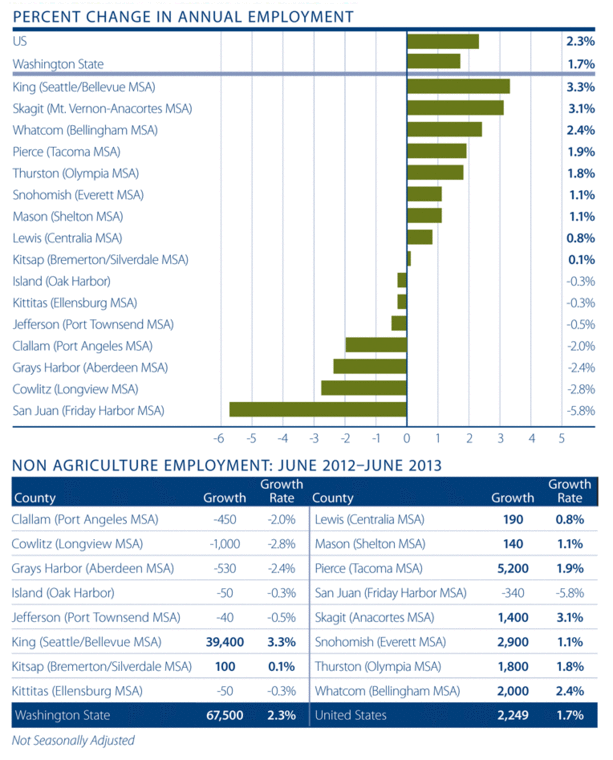

Regional Real Estate
We have been looking for balance within the real estate market for several years now. During the crash, there were clearly far more sellers than buyers, but when we found the bottom of the market and prices started to rise, the tables were turned with considerably more buyers than sellers. In as much as we are still far from truly finding the market equilibrium that we have all been waiting for, I am pleased to announce that we are getting closer.
The region contained within this report reported 19,158 sales in the first half of 2013—a 16 percent improvement over the same period in 2012, and a remarkable 51 percent improvement over the first quarter of 2013.
All but two counties saw sales improve in the first half of the year compared to the first half of 2012, with only modest declines in San Juan and Grays Harbor Counties. When comparing sales volumes between the first and second quarters of this year, not only did every county other than San Juan see the number of transactions improve, but there were also some remarkable spikes.
In Kittitas County, for example, sales grew by 82 percent between first and second quarters. All the counties analyzed experienced double-digit sales growth, apart from the volatile San Juan County where sales dropped by two percent.
This is very positive but does not address the issue of supply.
I was pleased to see a long-awaited improvement to inventory levels. Within the area encompassed in this analysis, current listings were measured at 19,185. This is still down by 11.6 percent from the same period in 2012, but it is up by over 29 percent from the end of the first quarter, and up by 8.4 percent over May’s total listings.
The number of homes for sale grew the most in Kittitas County, where listing inventory was 50 percent above that seen at the end of the first quarter. This was followed by Jefferson (+47%), Clallam (+42%), King, and Snohomish Counties, which each expanded their listing inventory by 41 percent. As compared to May of 2013, listings increased the most in Snohomish County (+15%), followed by Clallam (+14%), King (+11%) and Jefferson (+10%) Counties.
That said, I would note that total listing activity is still down by 49 percent over June 2008. In as much as I doubt that we will see that type of activity in the foreseeable future, we are getting back to levels of inventory that were seen in the earlier part of the last decade.
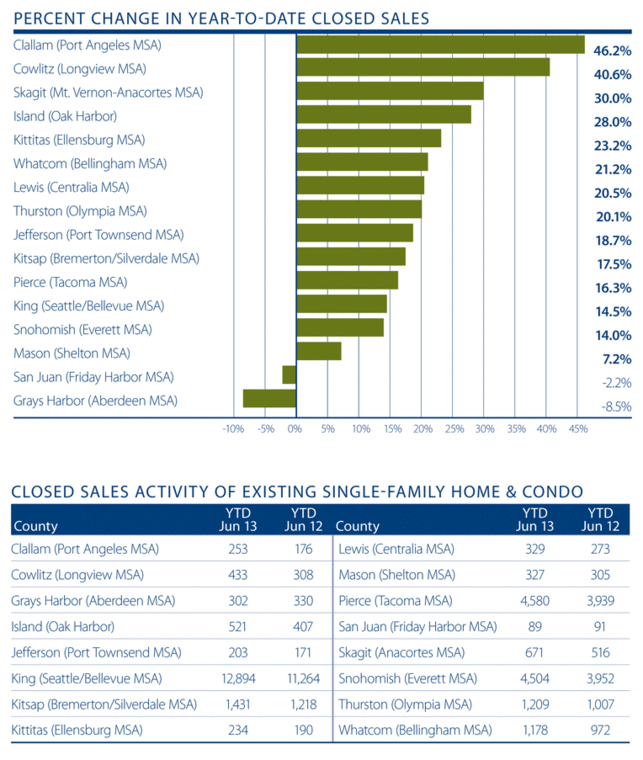
As shown in the chart to the right, 14 counties saw an increase in average sales prices as compared to a year ago, with just two exhibiting prices below that seen in June of 2012. In aggregate, home prices in the counties analyzed were 10.2 percent higher at the end of the second quarter of 2013 than seen a year previously.
Of the counties that saw appreciation, the most pronounced gains were in Cowlitz County, where prices rose by 24.4 percent. Significant additional gains were seen in Island (+17%), Pierce (+16.6%), San Juan (+16.1%), Kittitas (+15.2%), and Skagit (+15%) Counties. Declines were limited to Kitsap (-3.7%) and Thurston (-0.9%) Counties.
When we look at the entire second quarter, the average sales price for the region grew by 11.4 percent. The greatest quarterly improvement was seen in Mason County, where prices rose by 28 percent. In total, eleven counties saw sale price growth in the quarter with five seeing a decline.
As we look along a more extensive timeline, we note that all but three counties saw sale prices in June at levels higher than those seen two years ago. Clearly this is encouraging. We are still at prices that are below those from June of 2008, but I believe that we are likely to see some counties exceed values seen five years ago in the not-too-distant future.
Interest rates spiked in June, following comments made by the chairman of the Federal Reserve, who suggested that the economy is improving and that the committee is considering tapering the purchase of both treasuries and mortgage-backed securities. This took the market somewhat by surprise and led to a very rapid increase in rates.
The effect of this is still unclear and rates have pulled back modestly since
the peak seen in early July. What is clear, however, is that this move has motivated many would-be buyers that were thinking of getting into the market to get off the fence and into the hunt! This is putting increasing demand on the market and, I believe, should lead anyone thinking of listing their home for sale to seriously consider marketing earlier than later. Rates are highly unlikely to go down and, ultimately, purchasing power will decline if they rise more rapidly.
I am upping the housing market’s grade from a “C” to a “C+”. We still need substantially more listings in our market but, all in all, we are heading in the right direction.
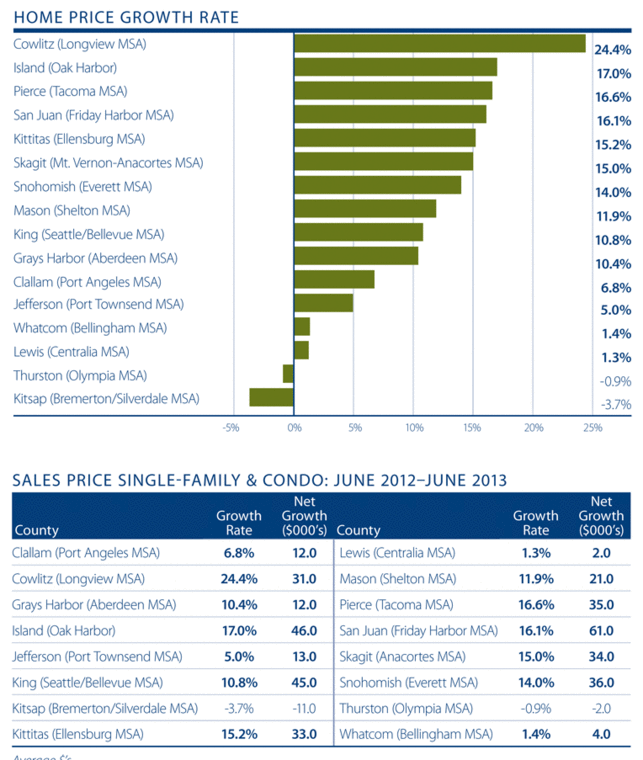
Conclusions
Our economy continues to expand at a rate that exceeds the U.S. rate, as well as that of three-quarters of the country.
If there is some news that is not quite so positive, it is that we are seeing job gains in industry sectors that are not particularly high-paying. This can have a negative effect on consumer spending and slow our overall growth.
That said, gains are gains! The increase in the unemployment rate is not something to get worried over. In fact, to some degree, it should be lauded. More people deciding to look for work is certainly indicative of an improving business environment.
As far as the housing market is concerned, improvement is steady, but at the risk of sounding like a broken record, we need more inventory. I also stand by my earlier statement that those considering selling their home may be well advised to get going sooner than later. Waiting for prices to rise further may be a folly in an environment where interest rates are increasing. It is also interesting to note that every one percent increase in interest rates drops purchasing power by 10 percent. Food for thought!
In all, I remain pleased with our progress to date. As I think about the last five years that this report has been in existence, I am reminded of the times when it was very hard to find any positive news to report. Times have certainly changed and I remain optimistic that I will continue to be able to discuss positive news as we move forward.
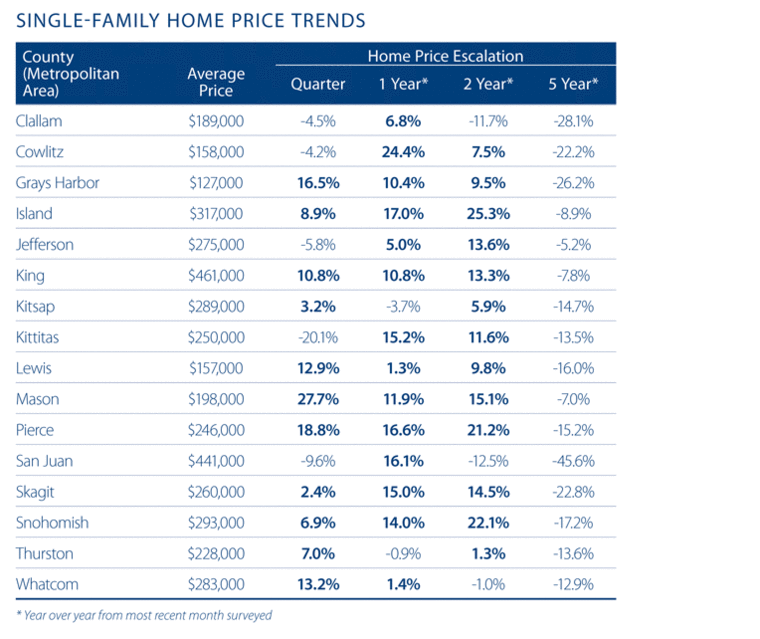
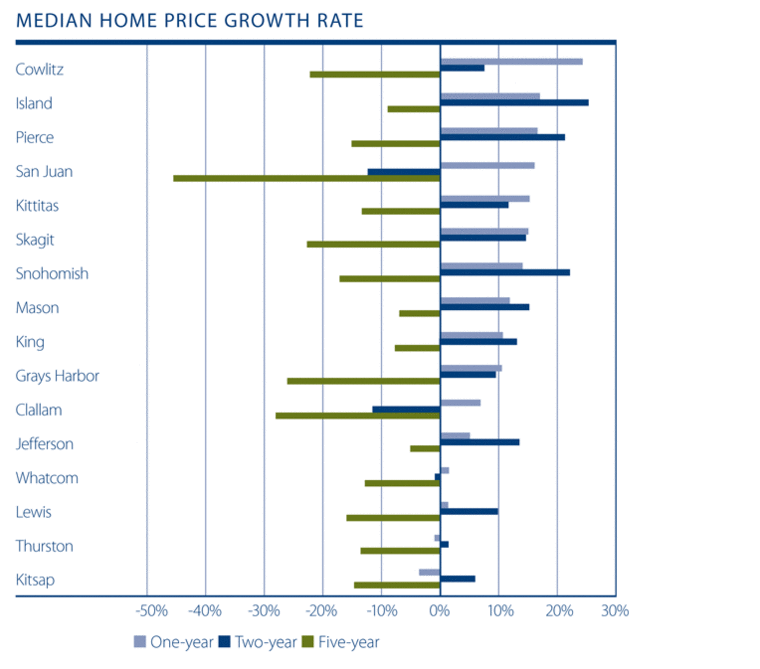
 Matthew Gardner
Matthew Gardner
Mr. Gardner is a land use economist and principal with Gardner Economics and is considered by many to be one of the foremost real estate analysts in the Pacific Northwest.
In addition to managing his consulting practice, Mr. Gardner chairs the Board of Trustees at the Washington Center for Real Estate Research at the University of Washington; sits on the Urban Land Institutes Technical Assistance Panel; is an Advisory Board Member for the Runstad Center for Real Estate Studies at the University of Washington; and is the Editor of the Washington State University’s Central Puget Sound Real Estate Research Report.
He is also the retained economist for the Master Builders Association of King & Snohomish Counties. He has twenty-five years of professional experience in the U.K. and U.S.
He has appeared on CNN , NBC and NPR news services to discuss real estate issues, and is regularly cited in the Wall Street Journal and all local media.
 Facebook
Facebook
 X
X
 Pinterest
Pinterest
 Copy Link
Copy Link
